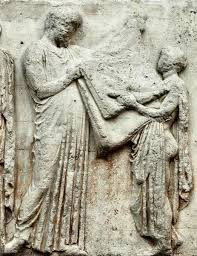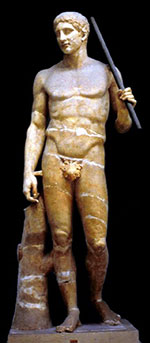
Classical Greek sculpture: Discobolos (the Discus Thrower) (This is a Roman copy; the Greek one didn’t last)
After the Severe style
The Severe style didn’t last very long, and by about 460 BC Greek sculptors moved on to the Classical style.
The Severe style
Women in the Severe style
Classical Greek history
All our Ancient Greece articles
Greek sculptors began to experiment with honoring the gods by showing the beauty and grace of the human body, especially the bodies of young, athletic men (They still didn’t carve women’s bodies without their clothes).
Greek athletic games
Three-dimensionality
The sculptors also became more interested in the three-dimensionality of sculpture: people being able to see a piece from all different sides, and not just from the front.

The center of the Parthenon frieze: a woman and a girl fold a cloth
The sculptor Phidias
One of the most famous sculptors of the Classical period was Phidias (FI-dee-ass). His most famous work does not survive: it was a great gold and ivory (chryselephantine) statue of Zeus for the temple of Zeus at Olympia, made about 440 BC.
Temple of Zeus at Olympia
The Parthenon in Athens

Phidias’ wine cup, with his name carved on the bottom
(But archaeologists did find Phidias’ own wine-cup, in his workshop at Olympia!) Phidias also was responsible for the sculptures on the Parthenon, though he could not have carved all of them himself because there are too many.

Doryphoros; Vatican museum, Rome
Parthenon sculpture
The figures on the Parthenon represent human perfection. The people (and the gods) are shown serene, calm, peaceful, in control of their emotions and their bodies, like dancers or as in Tai-Chi.
Sophocles’ view of people
People, to Phidias, and to other Greeks of this time, are wonderful creations of the gods, beautiful, strong, intelligent, and rational. Phidias is still carving women with their clothes on, but the clothes are practically transparent, and Greek sculptors were plainly beginning to think about taking them off.

Demeter, on the pediment of the Parthenon
Polycleitos
Another Greek sculptor of the classical period was Polycleitos (polly-KLY-tos), who carved the famous Doryphoros, meaning spear-carrier. As with most Greek statues, this statue is lost, and only a later Roman version of it survives. By about 340 BC, sculptors were moving into a new style of art we call the Hellenistic.
Learn by doing: making a Greek discus
More about Hellenistic sculpture
Bibliography and further reading about Classical Greek sculpture:
Greek Sculpture: The Classical Period, a Handbook, by John Boardman (1985). The standard text for introductory college classes.
The Archaeology of Greece: An Introduction, by William R. Biers (1996). Biers writes very clearly and has a lot of good pictures.
Greek Art and Archaeology (3rd Edition), by John G. Pedley (2002) This has a lot of good information and is pretty readable. Plus, the author is really an expert in this field.




